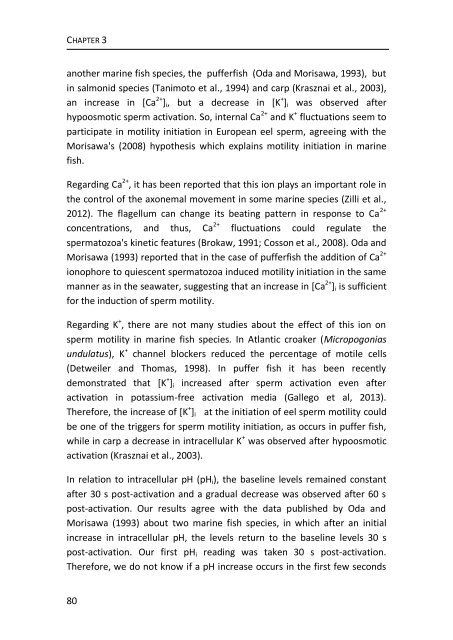chapter 3 - RiuNet
chapter 3 - RiuNet
chapter 3 - RiuNet
Create successful ePaper yourself
Turn your PDF publications into a flip-book with our unique Google optimized e-Paper software.
CHAPTER 3<br />
another marine fish species, the pufferfish (Oda and Morisawa, 1993), but<br />
in salmonid species (Tanimoto et al., 1994) and carp (Krasznai et al., 2003),<br />
an increase in [Ca 2+ ] i , but a decrease in [K + ] i was observed after<br />
hypoosmotic sperm activation. So, internal Ca 2+ and K + fluctuations seem to<br />
participate in motility initiation in European eel sperm, agreeing with the<br />
Morisawa's (2008) hypothesis which explains motility initiation in marine<br />
fish.<br />
Regarding Ca 2+ , it has been reported that this ion plays an important role in<br />
the control of the axonemal movement in some marine species (Zilli et al.,<br />
2012). The flagellum can change its beating pattern in response to Ca 2+<br />
concentrations, and thus, Ca 2+ fluctuations could regulate the<br />
spermatozoa's kinetic features (Brokaw, 1991; Cosson et al., 2008). Oda and<br />
Morisawa (1993) reported that in the case of pufferfish the addition of Ca 2+<br />
ionophore to quiescent spermatozoa induced motility initiation in the same<br />
manner as in the seawater, suggesting that an increase in [Ca 2+ ] i is sufficient<br />
for the induction of sperm motility.<br />
Regarding K + , there are not many studies about the effect of this ion on<br />
sperm motility in marine fish species. In Atlantic croaker (Micropogonias<br />
undulatus), K + channel blockers reduced the percentage of motile cells<br />
(Detweiler and Thomas, 1998). In puffer fish it has been recently<br />
demonstrated that [K + ] i increased after sperm activation even after<br />
activation in potassium-free activation media (Gallego et al, 2013).<br />
Therefore, the increase of [K + ] i at the initiation of eel sperm motility could<br />
be one of the triggers for sperm motility initiation, as occurs in puffer fish,<br />
while in carp a decrease in intracellular K + was observed after hypoosmotic<br />
activation (Krasznai et al., 2003).<br />
In relation to intracellular pH (pH i ), the baseline levels remained constant<br />
after 30 s post-activation and a gradual decrease was observed after 60 s<br />
post-activation. Our results agree with the data published by Oda and<br />
Morisawa (1993) about two marine fish species, in which after an initial<br />
increase in intracellular pH, the levels return to the baseline levels 30 s<br />
post-activation. Our first pH i reading was taken 30 s post-activation.<br />
Therefore, we do not know if a pH increase occurs in the first few seconds<br />
80
















